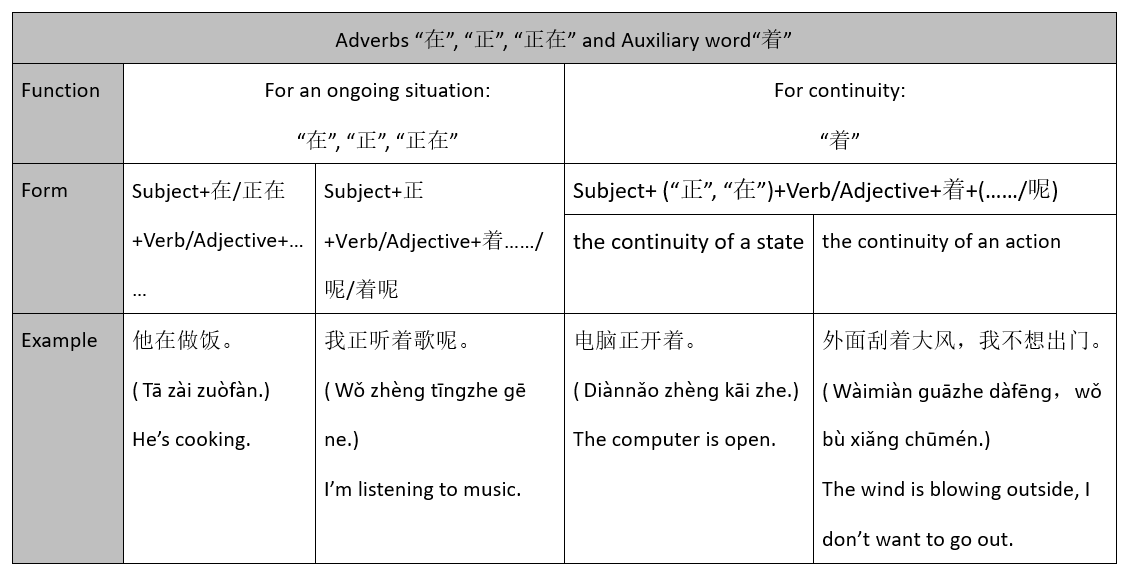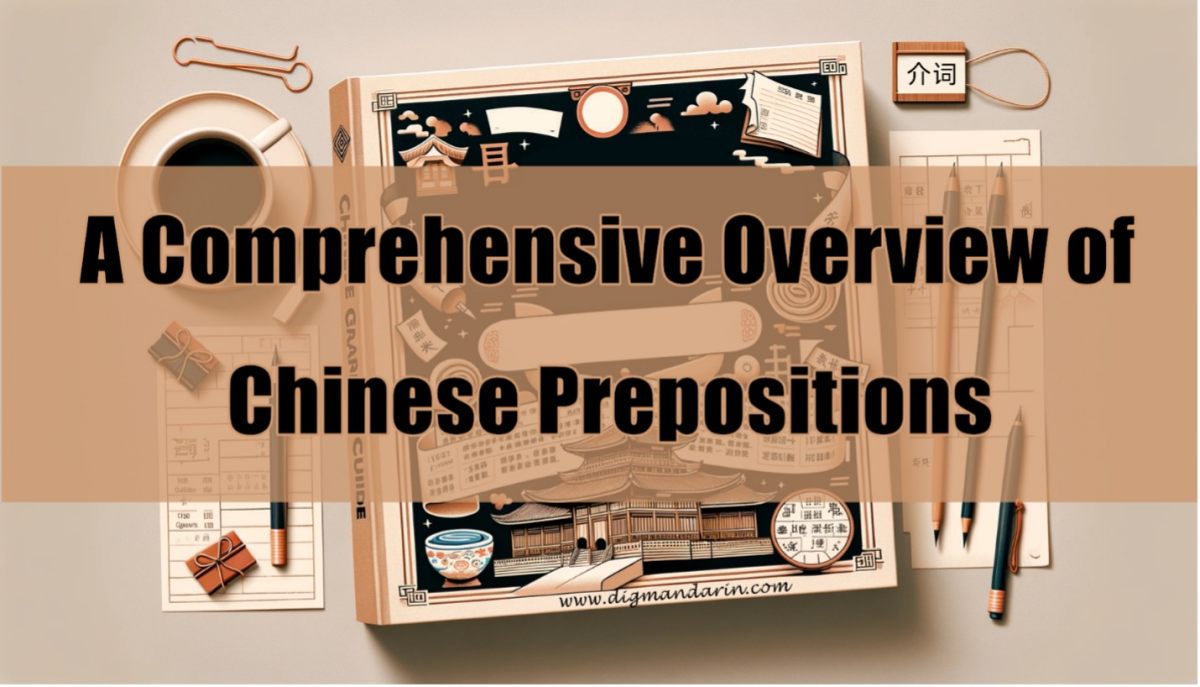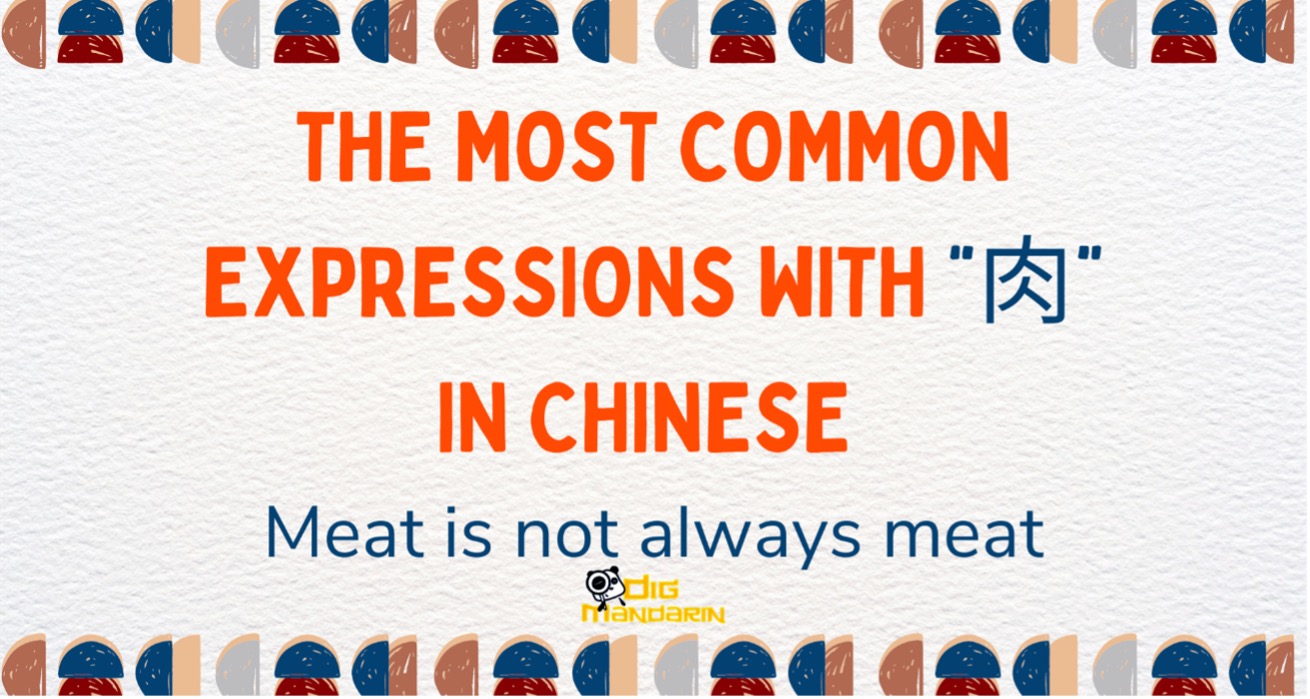Mastering Chinese Verb Continuity: How to Use 在, 正, 正在, and 着
When learning a new language, one of the fundamental aspects to grasp is how tense and continuity are expressed. One of the intriguing distinctions between Chinese and English lies in how they handle the ongoing continuity of actions and states. While English alters verb forms to indicate the ongoing nature of an action, Chinese opts for a different strategy, relying on specific words to convey this concept. In this article, we’ll delve into this fascinating aspect of the Chinese language: the utilization of words like 在 (zài), 正 (zhèng), 正在 (zhèngzài), and 着 (zhe).
Join us as we uncover the meanings, applications, and nuances behind these essential words in Chinese. By the end of this article, you’ll have a solid foundation for confidently using these terms to convey the ongoing nature of actions and states in the Chinese language.
1. Differences Between 在, 正 and 正在
Form 1: Subject+在/正在+Verb/Adjective+……
在(zài) stresses the continuous condition of an action. 正在(zhèngzài) is used when we want to show that the action is both current and still in progress.
For example:
我在/正在看电视。(Wǒ zài/zhènɡzài kàn diànshì.
I am watching TV.
整个上午她都在哭。(Zhěnɡɡè shànɡwǔ tā dōu zài kū.)
She was crying all morning.
Form 2:Subject + 正 + Verb/Adjective + 着……/呢/着呢
正(zhèng) shows the timing of an action. This one is not usually used with short verbs. It is most often used with longer verbs or adjectives.
For example:
他正忙着,没看到你。 (Tā zhènɡ mánɡzhe, méi kàndào nǐ.)
He is busy, so he can’t see you.
(京剧) 我正看着呢。((Jīnɡjù) wǒ zhènɡ kànzhe ne.)
(Peking Opera) I was watching it.
Note that we can make 在(zài) stronger with words like 又(yòu), 一直(yìzhí), 总(zǒnɡ), and 还(hái). But 正在(zhèngzài) can’t be used this way.
For example:
这些天他一直在想出国的事。(Zhèxiētiān tā yìzhí zài xiǎnɡ chūɡuóde shì.)
He has been thinking about going abroad these days.
你又在喝酒了。(Nǐ yòu zài hējiǔ le.)
You’re drinking again.
他总在说过去的经历。(Tā zǒnɡ zài shuō ɡuòqùde jīnɡlì.)
He’s always talking about the past.
过去一周,他都在写论文。(Guòqù yìzhōu, tā dōu zài xiě lùnwén.)
He has been writing papers for the past week.
When it comes to the word 正(zhèng), there’s something interesting to note. It usually doesn’t go with just one simple verb, especially if it’s a monosyllabic one. Instead, it’s commonly used in this pattern: Subject + 正 + Verb/Adjective + 着……/呢/着呢. On the other hand, 在(zài) and 正在(zhèngzài) don’t have this kind of rule.
For example:
我正在吃晚饭。(Wǒ zhènɡzài chī wǎnfàn.)
I’m having dinner.
我在看。(Wǒ zài kàn.)
I’m watching.
2. How to use 着 to express ongoing states and actions
When you want to show that an action or a state is ongoing, you use the word 着 (zhe). It’s like a helper that indicates when something is happening.
Form 3:Subject + Verb/Adjective +着……
For example:
冰箱开着。(Bīnɡxiānɡ kāi zhe.)
The refrigerator is open.
你说,我听着。(Nǐ shuō,wǒ tīnɡ zhe.)
You speak, and I listen.
她一路唱着不知名的歌。(Tā yílù chànɡzhe bù zhīmínɡ de ɡē.)
She sang an unknown song all the way.
If you want to highlight that something is happening right now, you can use 着(zhe) along with 正(zhèng) or 在(zài), or you can add 呢(ne) at the end of the sentence. This helps draw attention to the ongoing state of things. Here’s how it works:
Form 4: Subject + (正, 在) + Verb/Adjective +着 + (……/呢)
Usually, when you’re talking about the continuity of a state, it’s the state of an object. But if it’s not, then the verb or adjective is usually something like 坐 (zuò, sit), 站 (zhàn, stand), 等 (děng, wait), and so on.
For example:
灯开着呢。(Dēnɡ kāi zhe ne.)
The light is open.
窗户正开着,雨飘了进来。(Chuānɡhu zhènɡ kāizhe,yǔ piāole jìnlái.)
The windows were open and the rain drifted in.
(你)别坐着了,起来走走。((Nǐ)bié zuòzhe le,qǐlái zǒuzou.)
(You) Don’t stay seated, get up and walk.
When you want to tell others that an action is still happening, you can use 着(zhe). Here’s the trick: the subject doing the action can be a living thing, like a person or an animal.
For example:
兔子正高兴地吃着胡萝卜。(Tùzi zhènɡ ɡāoxìnɡdi chīzhe húluóbo.)
The rabbit is happily eating carrots.
我听着音乐,不说话。(Wǒ tīnɡzhe yīnyuè,bù shuōhuà.)
I am listening to music, not speaking.
Note:
Here are situations where we can’t use 着(zhe):
For example:
(1)—你在干/想什么?(Nǐ zài ɡān/xiǎnɡ shénme?)
What are you doing/thinking about?
—我在看电视。(Wǒ zài kàn diànshì.)
I’m watching TV.
—我在想今天的作业。(Wǒ zài xiǎnɡ jīntiānde zuòyè.)
I’m thinking about today’s homework.
(2)—你在等谁?(Nǐ zài děnɡ shuí?)
Who are you waiting for?
—我在等李华。(Wǒ zài děnɡ Lǐhuá.)
I’m waiting for Lihua.
We’ve learned that 在(zài), 正(zhèng), and 正在(zhèngzài) are handy signals to show that an action is still happening. On the other hand, 着(zhe) comes after verbs and adjectives to let us know an action or state is continuously going on.
It’s important to note that 着(zhe) is mainly used to describe things. In the examples above, the speaker emphasizes the ongoing action itself, rather than when or how it ends. That’s why 着(zhe) doesn’t fit there.
For a better understanding, see the chart below:

Chinese stands out with its unique approach to expressing the ongoing continuity of actions and states. While other languages often rely on verb conjugations to convey tense, Chinese employs a set of distinct words – 在 (zài), 正 (zhèng), 正在 (zhèngzài), and 着 (zhe) – to paint a vivid picture of actions and states in progress. The distinctions between 在(zài), 正(zhèng), and 正在(zhèngzài) highlight the interplay of action conditions and time frames, while 着(zhe) adds depth to the portrayal of ongoing actions and states. Remember, these four words are like tools in your language toolbox. They help you paint a clear picture of what’s happening around you! Understanding when and how to use these words not only contributes to accurate communication but also offers a glimpse into the linguistic subtleties embedded within the language. We hope this article has shed light on this surprisingly complex aspect of the Chinese language, guiding you toward a confident mastery of expressing verb continuity.





I have been learning Chinese grammar. 我正学着中文语法。Is this the correct way to translate?